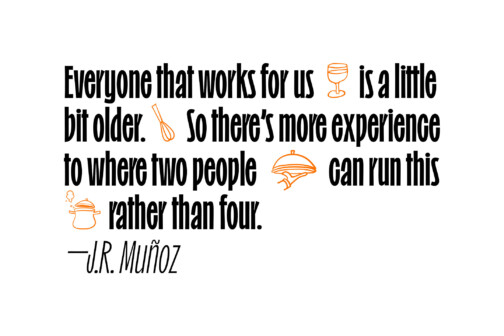Welcome to In the Weeds, our series in which Dallas restaurateurs explain behind-the-scenes aspects of the food service business—parts of the job that customers never see. Today we’re talking about staffing: how many employees a restaurant needs, how businesses decide on staffing levels, and the challenges of the current hypercompetitive market.
Meet our experts:
- Sawsan Abublan, co-owner of fast-casual chain Shawarma Press
- Tanner Agar, co-owner of upscale restaurant Rye and cocktail bar Apothecary
- Jon Alexis, restaurateur behind TJ’s Seafood, Malibu Poke, Escondido, and Ramble Room
- J.R. Muñoz, owner of the bars Will Call and Elm Street Saloon
- Khanh Nguyen, restaurateur behind ZaLat Pizza and DaLat
- Brent and Juan Reaves, co-owners of Smokey John’s Bar-B-Q
Here’s what they have to say about finding and keeping employees. (My comments and subject transitions are in italics.)
Read part one: What Must Happen Before a Restaurant Can Open?
Part two: How Do Restaurants Choose Their Locations?
Part three: What Are the Most Surprising Hidden Costs of the Restaurant Business?
Part four: How and When Do Restaurants Decide to Raise Prices?
How a restaurant hires before it opens
The challenge of staffing begins before you open. For one thing, you have to train everyone. For another, you have to calculate how many employees you’ll need, which, until your business opens, involves some guesswork.
Jon Alexis: You have a labor budget before you even open. That’s your training budget. Those managers need to understand that restaurant before they can hire service and line cooks, and service and line cooks have to be compensated to learn the restaurant. Let’s say I’m going to bring my managers on a month before we open. If the permit office gets delayed, now that manager’s on for six weeks.
You overstaff a restaurant at first. There’s attrition. You want it to be a meritocracy and there to be a little competition and see who can cut it. And you want to make a great impression on those first guests.
Khanh Nguyen: When we open a place, we have kind of a feel in terms of where it will start out in terms of volume. We know we’ll need a GM, a couple of shift leads, and so many cashiers and so many cooks. That’s what we try to hire to.

Tanner Agar: The hardest part before you open is trying to determine how much traffic are we going to have. If you have too many people you’re bleeding money, if you have too few people, you’re stressing your cooks and they’ll leave. You have to guess based on what you’re guessing traffic is going to be. When we opened in McKinney, no one was coming to the restaurant. We had more people getting paid in the building than were sitting in the dining room. That is not a business model that works.
It’s very hard to lure people to a new concept, especially if you’re unestablished as a restaurateur. That’s something that we faced when we came down here [from McKinney]. We went to open Apothecary and we said [in job interviews] we wanted to be the most aggressive program in the city, all these tools, all these ingredients, everything is available. Everything is on the table. And while we were able to get some people with this—“wow, I can literally I can make whatever I want? I can make a hummus cocktail?” “Yes, please make a hummus cocktail”—at the same time, it was difficult for sure. [Possible employees] were like, “is anybody going to come to this bar? Do you know how to run a bar?”
Full employment, fair wages, and keeping your employees
Next, our panelists offered general advice on keeping a restaurant fully staffed: how many people it takes, how things change seasonally, part-timers and full-timers, and why it’s nice to have more experienced employees.
Juan Reaves: You’ve got to hire a bunch of folks. Some days, you find yourself overstaffed, you have to send people home, but it’s a better situation than being understaffed and not being able to not have anybody to come in.
Sawsan Abublan: It really all depends on whether you have everybody as a full-time employee or a part-time employee. It’s coverage. We call it covers. So for example, we say that we need four people in front of the house and then just two people in the back. However that works itself out, whether they’re part-timers or full-timers, as long as I have that coverage throughout the open hours, then I’m in good shape.
Tanner Agar: There’s a certain amount of saying, in our concept servers have a four-table section, or a six-table section, we have X number of tables, so we need X number of people.
Sawsan Abublan: We look forward to the summer break, but it’s also bittersweet because we know we’re gonna have this nice break from worrying about employment and then once August comes near, we will start sweating again. During the summer, those school kids are flexible. Then once school opens, that’s it. Whoever you had covering your mornings is no longer there and you have to go search for somebody else.
J.R. Muñoz: Everyone that works for us is a little bit older. So there’s more experience, to where two people can run this rather than four. If you come in Monday through Thursday night, we’ll have two people here. Maybe a door guy. I love this place to have a neighborhood vibe, so I don’t mind being slower during the week. Weekends we staff up because we’re on the corner. We have a great location, so we’re gonna get busy. Or, in football season, you get everybody in town on Thursdays and Fridays for the game and they want to party all weekend.
One more tip: in the current labor market, pay your employees fairly. They know how much money they can make elsewhere.
J.R. Muñoz: You gotta understand now, McDonald’s pays $16 an hour. You got to up it. I see businesses on those industry websites all the time that are like, “Hiring a line cook, $12 an hour, $13 an hour to start off.” And I’m like, there’s a reason why I see you on this page every single week.
To some extent, though, all the restaurateurs agreed that the current reality of the labor market is more important than any theoretical notions about an ideal staff level.
Sawsan Abublan: The labor market these days kind of dictates itself on you.
Tanner Agar: If I was opening a restaurant right now as a new restaurateur, I would be more concerned about how I get the right number of people to agree to work here. Not what is the right number of people.
Brent Reaves: For many years, we would hire ex-offenders, people who a lot of times people weren’t given a chance. Now that [history] doesn’t matter anymore. With the recent issues in the workforce, everybody is getting hired. Our standards have stayed the same, but our pool just got smaller.
Juan Reaves: Everybody has realized that [ex-offenders] have something to offer and they want to work. It’s good for them.
Khanh Nguyen: The world as it is right now, the problem is not figuring out how many we need to limit to. It’s as many as we can find, basically.
Get the SideDish Newsletter
Author





